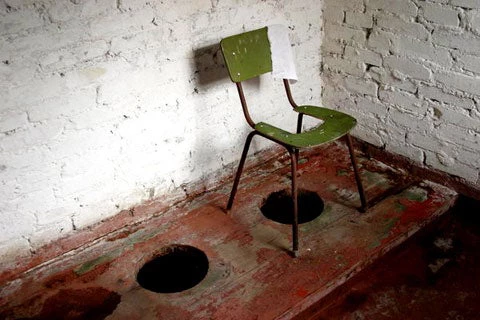Submitted on Mon, 11/19/2012 - 10:33
Toilets - everyone has a story to tell about these. The World Bank’s Europe and Central Asia online communications team reflects on global sanitation issues and their personal experiences on World Toilet Day.
Up to the Knees, Down to the Knees
John Mackedon (USA), Online Communications Officer
“Up to the knees – down to the knees.” Though nonsensical the first time I heard it, this mantra soon defined the five years I lived in the country, Georgia. Growing up in the United States had allowed me to remain ignorant of one of the most critical topics in the global health discourse: unsanitary toilets. This ignorance soon turned to shock, dismay and finally, acceptance, as I mastered rolling up pants and perfected a mean squat.
With World Toilet Day upon us, I reflect on this transformation and my thoughts go out to anyone around the world who is denied access to such a fundamental need. I think back on some of most unsavory locations I have encountered over the years and am acutely aware that even today, someone might consider that an unknown luxury. I hope there comes a day when “up to the knees – down to the knees” seems as unfamiliar to anyone in the developing world as it once did to me.
What’s Your Bowl?
Sogdiana Azhiben (Kazakhstan), Regional Online Communications Producer
After years of dealing with different toilet shapes and sizes in Central Asia, I still cannot determine what type I favor. (I know.) One of the first variations I encountered was in the early 1980s, in a small dorm-like apartment with only one public bathroom and few toilets on the entire floor. The flushing system was raised so high that kids had to ask adults to help them “pull the trigger.” In villages, outhouses with a pit in the ground were the norm. Villagers, who often built their own, competed on whose was fancier. Cleanliness, however, was always an issue.
In post-Soviet schools, most toilet bowls were cemented into the floor and afforded almost no privacy. Broken or open windows served as ventilation to the never-ending trickle of teachers and students. Finally, after the American toilet was discovered, odorous bathrooms and squat systems became a thing of the past. Today, bowls (inside and out), are actually major dictators of ambiance and opulence. So, what bowl do you fancy?
On the Run
Paul Clare (Ireland), Regional Online Communications Officer
Any marathon runner will tell you that despite all the training and preparation, when Mother Nature calls out on the road, you listen.
Thankfully these days, most marathon organizers place portable toilets (commonly called portaloos) along the 26.2-mile route -- indispensable in averting a sudden crisis!
Last year, when I dared to run the Dublin marathon, I had given little thought to hundreds of portaloos lining the streets, beyond the fact that they were there if needed. I never considered, for example, what would happen to them once the marathon ended and the clean-up began. I never asked myself back then, where all the waste would go, or how it would get there. Would there be an environmental impact?
World Toilet Day reminds me that we often pay attention only to immediate needs, without considering their wider implications – something I realize must change.
Public toilets: a litmus test for society
Artem Kolesnikov (Russia), Online Communications Producer
City planning and urban development plans sometimes omit the most obvious requirement -- public toilets. Your home toilet likely reflects your lifestyle, habits and social status. But public toilets – and their condition, availability, features and accessibility -- speak for the entire society.
Allow me to draw your attention to the public toilet you last visited. Then take -- The Good Toilet Test:
- Was it clean? Clean toilets = good public services and social awareness.
- Is it friendly to the disabled? Kids? Lactating mothers? Higher inclusiveness indicates advanced social development and protection.
- Got soap? Towels? It is likely that the presence of such items will indicate the level of public health awareness.
- Are there any signs of damage, vandalism or looting? (This one, for obvious reasons.)
How many public toilets have you seen where you live? One thousand? One hundred? Just one? None? And how often have you had to find one to use? Or do you just “buy” a cup of coffee at the nearest cafe to take care of urgent matters?


Join the Conversation